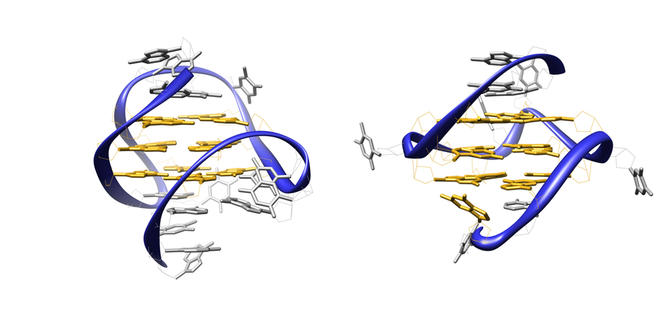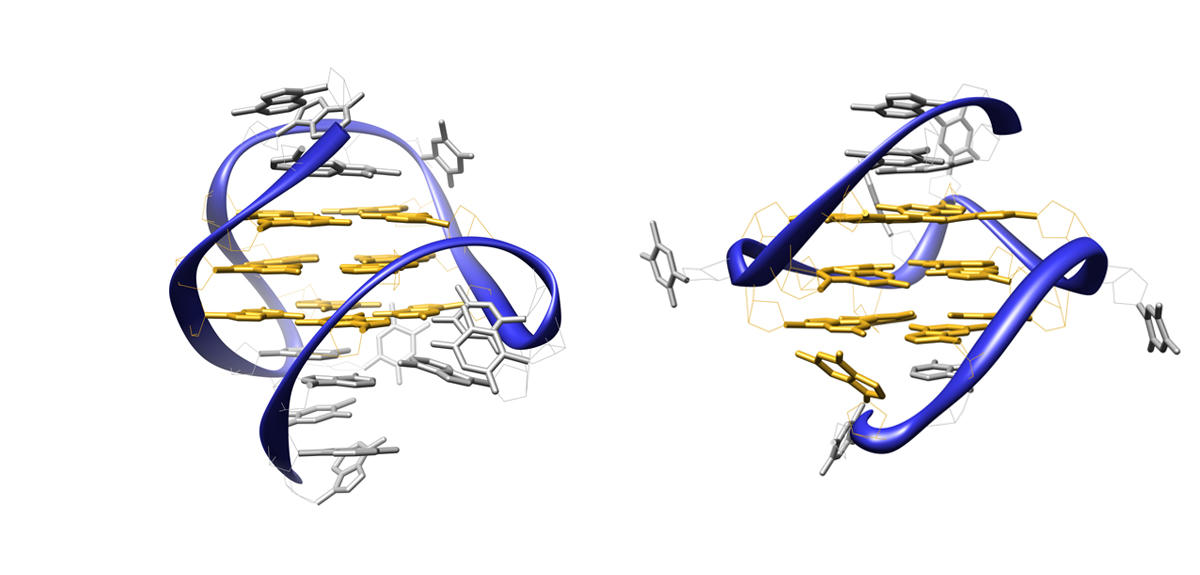You are here
Unlocking the Secrets of Four-Strand DNA

Though completely unfamiliar to many of us, DNA G-quadruplexes may force us to rewrite certain passages in biology manuals. More importantly, they could prove crucial in the fight against a number of serious diseases, principally cancer. One thing is certain: ever since the existence of these substances was first demonstrated in human cells in 2013,1 research in the field has grown exponentially.
“With the study of G-quadruplexes, we’re literally redefining the genetic code. They act like genetic switches that provide a new level of gene regulation,” enthuses the Dijon-based researcher David Monchaud.2
Unusual DNA structures
In concrete terms, G-quadruplexes are unusual DNA structures. The latter molecules are classically made up of two intertwining strands, each comprising nucleic acid bases (guanine, G, adenine, A, cytosine, C, and thymine, T) held together by weak bonds between the bases.
This is the famous double helix (or “duplex”) structure discovered in 1953 by biologists James Watson and Francis Crick. DNA G-quadruplexes, on the other hand, are structures comprising not 2, but 4 intertwining strands. “They are formed by the folding of guanine-rich DNA, with G bases self assembling to form a four-stranded structure rich in guanine. Hence the other name for these complexes: G4-DNA,” the researcher explains.
Another key characteristic of G-quadruplexes—in contrast with double-helix DNA, which is a permanent structure—is their highly dynamic and even furtive nature. “This is one of the main reasons why their existence in human cells has only been demonstrated very recently,” stresses Monchaud.
Found almost everywhere in genes and in all living beings
The latest data suggest that G-quadruplexes may form at no less than 716,000 points in our genome. Yet they appear to occur most frequently in telomeres, the areas found at the ends of chromosomes and which make them stable. They are also present in gene promoters (regions near the transcription start sites of genes and essential for their expression), particularly oncogene promoters, overexpression of which favors the development of cancer.
Further, other guanine-rich genetic molecules may also form G-quadruplexes, namely RNA, a substance chemically similar to DNA but comprising a single strand and essential for the production of proteins. Finally, G-quadruplexes are now thought to exist not just in human cells, but in all types of living cells, including plant cells, viruses and bacteria.
Numerous crucial biological mechanisms are affected
The chief appeal of G-quadruplexes to so many researchers is their possible roles in several key biological processes essential to proper cell functioning. These include chromosome stability, DNA replication (the mechanism that precedes cell division, allowing two identical molecules to be produced from a single DNA molecule), “transcription,” by which a strand of DNA is copied in a molecule of RNA, and “translation,” the process by which RNA is utilized to enable protein synthesis, and so on.
“Researchers initially considered G-quadruplexes as a clearly disruptive force for cells,” states Paris-based biologist Marie-Noëlle Prioleau.3 For example, several studies have in fact suggested that they act as a type of knot on DNA interfering with a protein function vital to replication: DNA polymerase.
However, “we have learned very recently that they may also constitute positive elements,” continues Prioleau. Thus, in a study published in 2014,4 her team showed that while G-quadruplexes may prevent ongoing replication, they are crucial in initiating this very process.
A fascinating therapeutic target in several serious diseases
Due to their potential involvement in the key biological processes cited above, G-quadruplexes may be involved in the development of a number of serious diseases: cancer, certain rare diseases (e.g., fragile X syndrome, etc.), neurodegenerative (Charcot’s disease, frontotemporal dementia, etc.), or infectious ones (herpes, AIDS, etc.). This has led to the idea of developing treatments targeting them in order to fight these diseases. “This is a fascinating prospect, particularly in rare and neurodegenerative diseases for which available therapeutic strategy is either very limited or non-existent,” says Monchaud.
But before being able to harness the powers of the G-quadruplexes, the researchers will have to answer a number of questions. Where, when and how do these structures appear in the life of cells? What are the systems regulating their formation? Can they be controlled? What therapeutic ends may be envisaged? And so on.
“One of the current challenges in research on quadruplexes is to develop imaging tools that let us observe them directly in living cells to understand their dynamics within the cell,” explains Monchaud, who is currently working towards this end.5 At the CNRS alone, dozens of teams of chemists, biologists and physicians across France are busy working on G-quadruplexes.
“Although this field of research is still emerging, it is developing very rapidly, to the point that it is becoming difficult, even for us, to keep track,” says Monchaud. “This is what makes G-quadruplexes so fascinating; while the study of these structures may be daunting at times, it is always scientifically stimulating.”
- 1. G. Biffi et al., “Quantitative visualization of DNA G-quadruplex structures in human cells,” Nature Chemistry, 2013. (5): 182-86.
- 2. Institut de chimie moléculaire de l’Université de Bourgogne (CNRS / Université de Bourgogne).
- 3. "Domaines chromatiniens et réplication" (CNRS / Institut Jacques Monod / Université Paris Diderot).
- 4. A-L. Valton et al., “G4 motifs affect origin positioning and efficiency in two vertebrate replicators,” EMBO J., 2014. 33(7): 732-46.
- 5. A. Laguerre et al., “Direct visualization of both DNA and RNA quadruplexes in human cells via an uncommon spectroscopic method,” Scientific Reports, 2016. 6: 32141.
Explore more
Author
A freelance science journalist for ten years, Kheira Bettayeb specializes in the fields of medicine, biology, neuroscience, zoology, astronomy, physics and technology. She writes primarily for prominent national (France) magazines.















